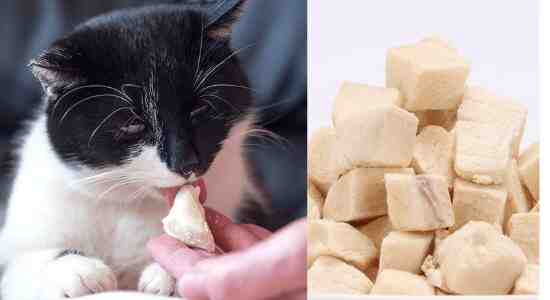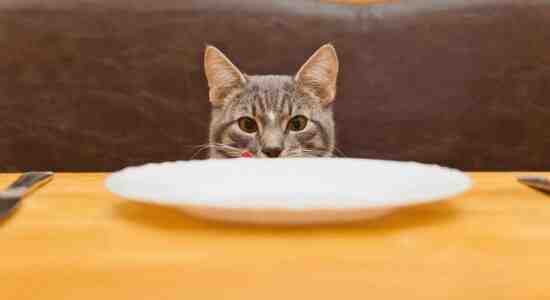Can Dry Cat Food Be Frozen? Dry cat food can indeed be frozen. The process is very simple and can be done at home. Before thawing the cat food, it must be placed in a plastic bag or container and sealed tightly to prevent any juices from seeping out and forming bacteria. However, once the cat has finished his meal, he will need fresh water left out for him to drink.
Freezing the cat food will not harm or alter its nutrition. It can be a better alternative to purchasing large quantities of dry cat food at once.
By freezing the cat food, one can create an extra supply for later or share with other cats currently owned by another family member.

This comes in handy when traveling and need to take the cat food along. Frozen dry cat food can last up to two months before it begins to lose its nutrients and begin spoiling.
If you are not planning on freezing your dry cat food, keep in mind that it will be stored longer than refrigerated, dry cat foods because cold temperatures work as a natural preservative.
Table of Contents
Can Dry Cat Food Be Frozen?
If you can’t use an entire bag of dry cat food within a couple of weeks, is it safe to freeze the remaining portion?
Freezing will not damage most pet foods. You may place unopened bags or cans of cat food in the freezer for up to one year without adverse effects. After thawing, however, you should use the food within two days.
Pre-portioned bags of dry cat food are available in pet supply stores and supermarket pet sections. These can be frozen to preserve freshness – up to one month for unopened packages or one day once opened. After thawing, discard any unused portion.
Thawed cat food can be refrigerated for up to three days.
Before serving, always check the product’s label for special handling instructions such as “Refrigerate after opening” or “Use within 24 hours.” If you don’t follow these instructions, your pet may get sick or even die.
Also Read: Does Dry Cat Food Go Bad?
How Long Can Cat Food Be Left Out?
You should throw away any uneaten food. Cats will eat cat food even if it’s not “fresh” any longer, but cats’ digestive systems can become upset by foods that are old or spoiled.
Foods left out more than 30 minutes may be contaminated by insects, rodents, or other animals; you shouldn’t let your pets eat these either.
Always store cat food tightly sealed and in a cool, dry place.
Primal Freeze Dried Cat Food Nuggets, Beef & Salmon Formula

How Do You Freeze Dry Cat Food?
First, measure out the portions you’ll use in one week. Label each container with the kind of food and date, then seal it well. Put your containers into a larger plastic bag or airtight freezer container — this will protect them from possible freezer burn.
Some pet supply stores sell special “meal-sized” cat food packages designed to be single-meal freezable portions. Again, be sure to label them first with the kind of food and date.
Don’t fill any plastic container more than three-quarters full to allow for expansion as the food freezes. If your cat’s portion makes a complete block of frozen food, you’ll need to let it partially thaw before cutting off the portion your cat will eat.
How Long Can Dry Cat Food Be Frozen?
If properly sealed and stored, most types of dry cat food will keep up to six months in your freezer.
However, this is only true as long as the seal remains unbroken and there’s no sign of damage like tears or dents. If you can see or smell mold, discard the food before the “best by” date.
Purina Cat Chow High Protein Dry Cat Food

Dry cat foods are subjected to extremely cold temperatures during manufacturing. They’ll keep longer in your freezer because they don’t stay at room temperature for extended periods.
Can You Refreeze Thawed Dry Cat Food?
If you thaw dry cat food, do not refreeze it even if it still contains ice crystals. Instead, use the same guidelines for frozen dry cat food: serve within 24 hours; store in the refrigerator for up to three days.
Do not attempt to refreeze any opened dry cat food (kibble or treats).
Can You Refreeze Meat-Based Cat Food?
Yes, but only if it’s unopened and still contains ice crystals. There may be some loss of quality because the food has been thawed, but this should be minimal.
Check the label if you have questions about whether a particular type of dry cat food can be refrozen. The manufacturer’s instructions should include specific wording such as “Refrigerate after opening; use within 24 hours” or “Freeze and keep up to 3 months.”
After thawing, discard any unused portion since bacteria can contaminate food left at room temperature for too long.
Northwest Naturals Freeze Dried Diet for Cats – Grain-Free, Gluten-Free Pet Food, Cat Training Treats

Can Dry Cat Food Freeze?
Yes! However, the quality and palatability of the food aren’t as good after it’s been frozen.
If you decide to freeze-dry cat food (kibble or treats), try only to do one week’s worth at a time — smaller, more frequent quantities are best. This will keep your freezer from becoming too full and help you avoid product loss to freezer burn.

If your dry cat food contains any “glop” or “gushy” ingredients, they won’t freeze well because these are low-moisture foods that can dry out completely in the freezer. Only some canned cat food is freezable; check the label to see which ones.
Once you’ve measured your portion, seal it well to protect against odors and freezer burn. Be sure to label the package first with the kind of food and date; if you include different flavors in one container, mark them clearly as “chicken,” “turkey,” or whatever other meats are included.
Is It Safe To Feed My Pet From A Frozen Bag Of Dry Cat Food?
Yes, but only if you are sure the food has maintained its original quality after being frozen. If you have any doubts about the flavor or texture change, serve it on a Thanksgiving dinner plate — go ahead and set out all the fixings to make it more festive!
What Is The Best Way To Store Dry Cat Food?
The best way to preserve the quality of dry cat food is to store it in a cool, dark, and dry place. Make sure your storage area isn’t so hot that temperatures can rise above 75 degrees Fahrenheit.
This type of cat food has a shelf life of about six months; after that, its flavor and nutrient content will be significantly reduced, and it can even become spoiled if left in a moist area.
The most common storage mistake is not sealing the bag properly when you first use it. Sometimes this means spilling cat food onto your floor or creating a sticky mess when you open the container for feeding time. Just remember to fold down the top of the bag before putting it away to prevent any accidents.
The best way to store cat food is in its original container inside a closed cabinet or cupboard — not on the kitchen counter where it’s more likely to be contaminated by odors, moisture, and other food. This will also help protect your pet from possible theft or tampering.
If you purchase large bags of dry cat food, use an airtight container. Some storage bins have a rotating wheel so you can easily access portions of food without having to dig through the entire bag every time it’s needed.
If you bring dry cat food inside for your pet, keep it in a covered container and store it inside a clean, closed cabinet or cupboard — not in the kitchen.
The Bottom Line
If you’re wondering whether can dry cat food be frozen, the answer is yes! It’s a great idea to keep some of your pet’s favorite foods on hand so that when they get sick or are recovering from surgery, you have their favorite food at the ready.
However, there are two critical things to remember before freezing any pet food–make sure it does not contain meat products and remove all moisture by running it through a dehydrator for 6-8 hours first. Other than those considerations, raw or cooked kibble will freeze well in an airtight container if done correctly.

Hi there! My name is Koushik; I am a cat lover. I specialize in writing about pet care & food. I have a wealth of knowledge on cat food niches and related subjects. I have worked in the pet industry for over 5 years and am passionate about helping cat owners provide the best care for their furry friends. With knowledge of cat food and nutrition, I aim to share their insights and help cat owners navigate the world of cat food niches. I enjoy playing with my two cats, reading, and exploring new cat food brands in my free time.